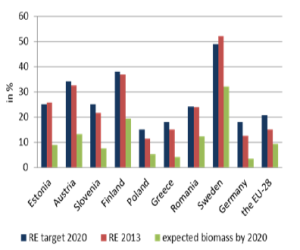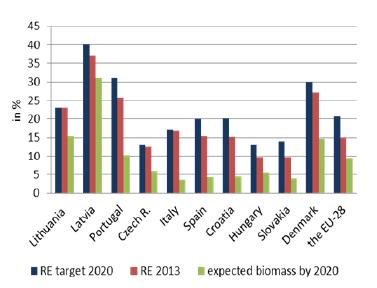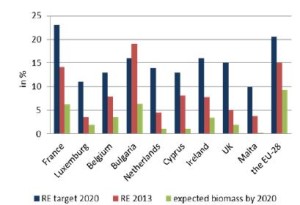The European Union has set ambitious targets of raising the share of EU energy consumption produced from renewable resources from 20% by 2020 to 27% by 2030. A study by Lappenranta University of Technology, the European Commission Joint Research Centre and Mikkeli Development Ltd, summarised available research, focused on countries’ specific woody biomass usage and ultimately assessed the role of biomass in renewable energy and the gross final energy consumption within the EU for 2020 and beyond. Specifically, it examined the expected contribution of biomass against the total renewable energy consumption in each member state by 2020. Further examination was undertaken on the total impact of solid biomass on the EU’s energy consumption, derived from renewable energy resources by 2020.
Woody Biomass Contributions
Member states were segmented into three groups to facilitate a deeper understanding of woody biomass resource potential within individual EU member states and the bloc as a whole. Ranked according to actual share of biomass via the National Renewable Action Plan (NREAP) and achievement of indicated bioenergy targets within the Horizon 2020 framework, states were ranked accordingly:
- Leading countries: Have met their renewable energy (RE) targets or have a difference of less than 15%. In these countries woody biomass already plays an important role in power generation, heating and cooling. This is the case of Austria and Finland for example. Another country in this group is Romania, where biomass is still lagging behind solar and wind, but it is very promising and the potential is high for the use of biomass in RH&C.

- Intermediate countries: Biomass needs to increase from 15% to 30% to attain a realistic likelihood of reaching their domestic targets. Increased share of woody biomass will probably growmore rapidly due to increased policy support for RE, particularly promotion in heat and electricity production. With mixed levels of biomass usage, however, the development of their renewable energy source potential collectively has faltered. This group includes Eastern countries such as Lithuania and Latvia and Mediterranean countries such as Italy and Spain.
- Lagging countries: Required biomass increase to successful achieve the predetermined target is more than 30%. Large unused potential solid biomass in Germany and France combined with potential import capabilities in UK, Belgium and Netherlands mean that if usage of woody biomass increased in these countries, whom hold amongst the highest energy consumption levels within the bloc, the overall RE share within the EU-28 would be significantly enhanced.It is expected that this group of member states will be reliant on the exporting capabilities of leading and intermediate countries.
The future progress and likelihood of achieving the EU targets can consequently be argued to be dependent on a number ofkey variables. As a counter measure to the ranging levels of policy support for bioenergy markets, it has been suggested that a consistent and “stable” support policy for the bioenergy markets is required. Furthermore, a decrease in incentives for fossil fuels through the reduction of subsidies is another of the key variables suggested to increase the likelihood of successfully attaining bioenergy targets. Policy support must also be combined with logistical support and improvement in the sustainability of biomass logistics. Opportunities should therefore be provided, and more attention ascribed to further mobilise the potential biomass resources of the EU and therefore utilise the biomass potential and also the combined heat and power production.
This post is based on the paper “How are the EU members states contributing to the 27% target for EU’s renewable energy consuption – the role of woody biomass“, S. Proskurina, R. Sikkema, J. Heinimö, E. Vakkilainen, presented at the 25th European Biomass Conference and Exhibition.




